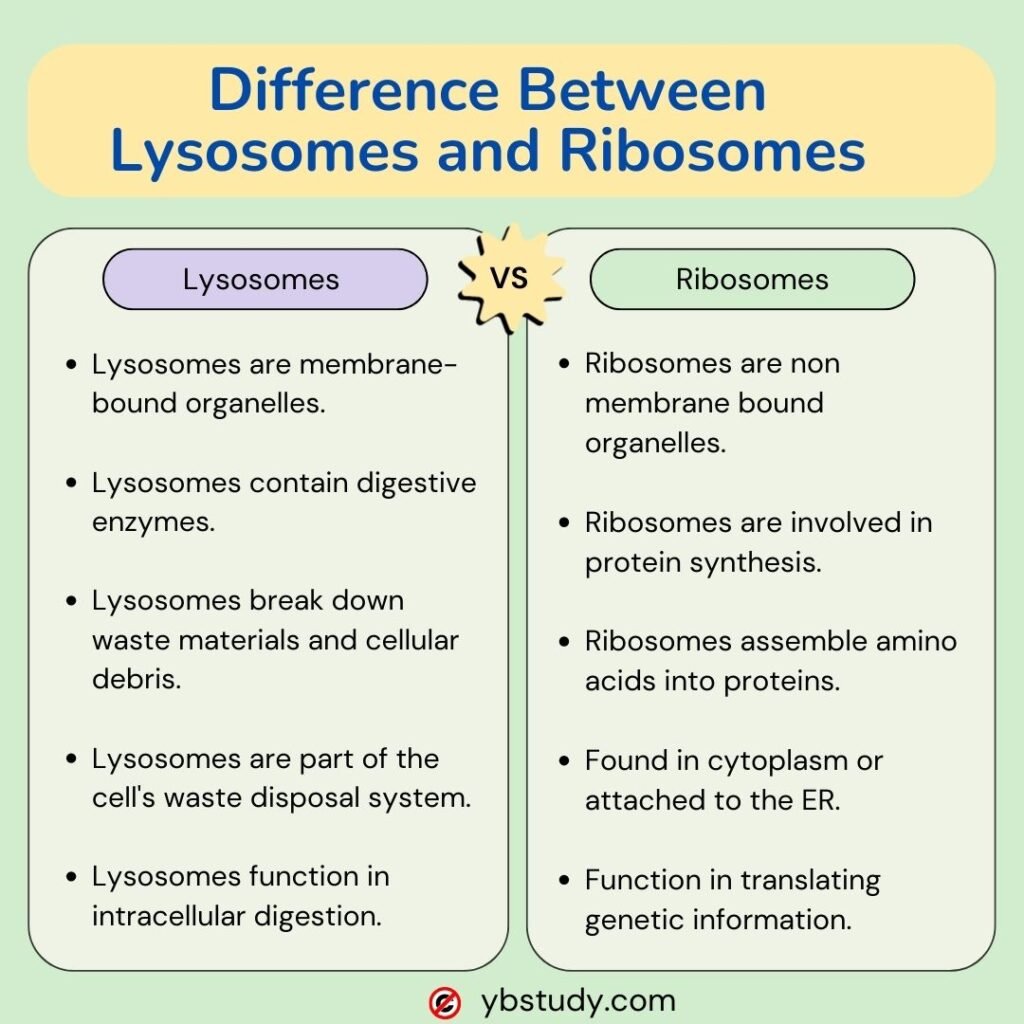10+ Key Difference Between Lysosomes and Ribosomes
The Difference Between Lysosomes and Ribosomes is that ribosomes are the organelles responsible for protein synthesis, while lysosomes are organelles that contain digestive enzymes.
Ribosomes are cellular organelles found in the cytoplasm and plasma membrane. They have a complex structure made up of proteins and RNA. Its main function is the synthesis of proteins from the information encoded in messenger RNA.
Lysosomes are a type of vesicle in eukaryotic cells that contain digestive enzymes. These enzymes are used to break down nutrients into smaller molecules that can be absorbed by the cell.
Lysosomes may also contain enzymes that destroy bacteria or other organisms that enter the cell.
10+ Key Difference Between Lysosomes and Ribosomes
Hello again! Recently I was talking to you about the What is the difference between viruses, bacteria, and microorganisms. Today I want to introduce you to another topic Difference Between Lysosomes and Ribosomes. Do you want to know more about these little protein factories? Keep reading!
| Lysosomes | Ribosomes |
|---|---|
| Lysosomes are membrane-bound organelles containing digestive enzymes that break down waste materials and cellular debris. | Ribosomes are cellular structures responsible for protein synthesis, translating genetic instructions from mRNA into polypeptide chains. |
| Lysosomes are membrane bound organelles are found in the cytoplasm. | Ribosomes are small circular particles attached to the Endoplasmic reticulum. |
| Composed of membrane proteins and digestive enzymes | Composed of rRNA and ribosomal proteins |
| They function as the cell’s recycling centers, breaking down old organelles and foreign substances. | Ribosomes are found in the cytoplasm or attached to the endoplasmic reticulum (ER) and are involved in assembling proteins based on genetic information. |
| Found only in eukaryotic cells | Found in eukaryotic and prokaryotic cells |
| Lysosomes are involved in cellular digestion, helping to maintain cellular homeostasis by recycling materials. | Ribosomes are essential for cell growth, repair, and maintenance, producing proteins that perform various functions within the cell and organism. |
| Size range: 0.1 micrometer to 1.2 micrometer | Size range: 20 nanometer to 30 nanometer |
| They contain hydrolytic enzymes that work best in acidic environments to break down molecules into simpler forms. | Ribosomes consist of two subunits: a large and a small subunit, each composed of RNA and proteins. |
| Lysosomes are mostly found in animal cells. Plant cells may have Lysosomes but they are not as important as in the case of plant cells. | Ribosomes are found in both eukaryotes and prokaryotes. |
| Examples of lysosomal enzymes include proteases, lipases, and nucleases. | Ribosomes translate mRNA sequences into amino acid sequences to build proteins necessary for cellular functions. |
| Plays a key role in intracellular digestion and destruction of dead cells | Plays a key role in synthesis of proteins and translation of mRNAs |
5 Key Difference Between Lysosomes and Ribosomes Image

What are Ribosomes?
Ribosomes are cellular organelles that are present inside all cells and are made up of ribonucleic acids (RNA) and proteins. They can appear in different states of dissociation. When they are complete, they can be isolated or form groups (polysomes).
Its size depends on the type of cells, with the average size of the ribosomes of a prokaryotic cell being 200 Å in diameter.
In this sense, an active eukaryotic cell contains approximately 10 million ribosomes, while a prokaryotic cell contains approximately 15,000 to 20,000 ribosomes (25% of the total cell mass).
The word ribosome comes from ‘ribo’ which means ribonucleic acid and from the Greek ‘soma’ which means body.
In eukaryotic cells, the ribosomes of the cytoplasm are called 80 S. In mitochondria and plastids of eukaryotes as well as in prokaryotes, they are 70 S. Both rRNAs and the subunits of ribosomes are usually named by their sedimentation coefficient in Svedberg subunits.
What are Lysosomes?
Lysosomes are a type of cellular organelles essential for cellular digestion. They are bubbles within the cytoplasm in which different hydrolytic enzymes are contained , that is, digestive, capable of breaking down complex molecules ( proteins , lipids , nucleic acids and carbohydrates) into much simpler molecules.
Lysosomes are present in all eukaryotic cells . They are created in the Golgi apparatus of the cell , from vesicles whose interior is necessarily acidic ( pH 5), and which is isolated from the rest of the cell so that digestive enzymes do not destroy it.
However, in some cellular processes, certain old organelles tend to fuse with lysosomes to be digested and make room for younger ones. This process is known as autophagy. Thus, lysosomes are essential for cell maintenance, which is why they are present in absolutely all animal cells . Its role in digestion can be affected by different congenital diseases, or have harmful consequences for the body, as occurs with gout or rheumatoid arthritis.
Lysosomes were discovered in 1974 by the Belgian biochemist Christian de Duve (1917-2013). This discovery, among others, earned him a Nobel Prize in Physiology.
